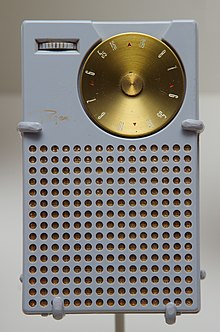Transistor radio
- This article is about an electronic device. For the fourth studio album by M. Ward, see Transistor Radio.

A transistor radio is a small transistor-based radio receiver. Historically, the term "transistor radio" refers to a radio that is monoaural and typically receives only the 540–1600 kilocycle[1] AM broadcast band.
History
In 1953 Intermetall unveiled what was probably the first transistorized portable radio on the Düsseldorf Radio fair.
The first commercial transistor radio, the Regency TR-1, was announced on October 18, 1954 by the Regency Division of Industrial Development Engineering Associates of Indianapolis, Indiana and put on sale in November of 1954. It cost $49.95 (the equivalent of $361 in year-2005 dollars) and sold about 150,000 units. Raytheon and Zenith Electronics transistor radios soon followed and were priced even higher. Even the first Japanese imports (in 1957) were priced at $30 and above. Transistor radios did not achieve mass popularity until the early 1960s when prices of some models fell below $20, then below $10 as markets became flooded with radios from Hong Kong by the mid to late 1960s.
Texas Instruments was behind the Regency transistor radio. In May 1954, they had designed and built a prototype and were looking for an established radio manufacturer to develop and market a radio using their transistors. None of the major radio makers were interested. RCA had demonstrated a prototype transistor radio as early as 1952 and it is likely that they and the other radio makers were planning transistor radios of their own. But as it often does in business, it took smaller, aggressive companies (like Texas Instruments and Regency) to push innovation forward. In Japan, big firms like Matsushita and Toshiba who might have been expected to push forward with a transistor radio acted more like their big American counterparts. It was Sony, then a small, aggressive concern, who produced Japan's first transistor radio, the TR-55 (in 1955). Sony's greatest success was the pocket-sized TR-63 released in 1957. It was the first transistor radio to utilize all miniature components and was the first Japanese radio to be imported into the U.S.A.
The use of transistors instead of vacuum tubes as the amplifier elements meant that the device was much smaller and required far less power to operate than a tubed radio. The typical portable radio of the fifties was about the size and weight of a lunchbox, and contained several heavy (and non-rechargeable) batteries: one or more so-called "A" batteries just to heat the tube filaments and a large 45- to 90-volt "B" battery to power the rest of the circuitry. By comparison, the "transistor" could fit in a pocket and weighed half a pound or less and was powered by standard flashlight batteries or a single compact 9-volt battery. (The now-familiar 9-volt battery was introduced specifically for powering transistor radios.)
Listeners sometimes held an entire transistor radio directly against the side of the head, with the speaker against the ear, to minimize the "tinny" sound. Most radios included earphone jacks and came with single earphones that provided middling-quality sound reproduction. Teenagers, with an earphone plugged into one ear, immersed in a private musical world, became a familiar sight, and one that made Ray Bradbury's description of "seashell radios" in his 1953 Fahrenheit 451 seem prescient. To consumers familiar with the earphone-listening experience of the transistor radio, the first Sony Walkman cassette player, with a pair of high-fidelity stereo earphones, would come as a revelation.

The transistor radio remains the single most popular communications device in existence. Some estimates suggest that there are at least seven billion of them in existence, almost all tunable to the common AM band, and an increasingly high percentage of those also tunable to the FM band. Some receive shortwave broadcasts as well. Most operate on battery power. They have become small and cheap due to improved electronics which pack millions of transistors on one integrated circuit or chip. The prefix "transistor" basically now means an old pocket radio; it can be used to refer to any small radio, but the term itself is today somewhat obsolescent, since virtually all commercial broadcast receivers, pocket-sized or not, are now transistor-based.
See also
Notes
External links
- [1] First Transistor Radio, 1953
- TI Information Bulletin First Commercial Transistor Radio October 18, 1954
- Website about the first transistor radio by Dr. Steven Reyer, a Professor in the Electrical Engineering and Computer Science Department at the Milwaukee School of Engineering.
- M31 Galaxy of Transistor Radios Transistor radio site with photos and info on classic transistor radios from the US, Japan, and Europe.
- RadioWallahHistorical data on transistor radios.
- ChildhoodRadios.com Website with restoration resources and community message board operated by Ron Mansfield
- Sarah's Transistor Radios Extensive website displaying over 1500 transistor radios and other information.
- Regency TR-1 Transistor Radio History: website with many historical references on the web and in published literature www.regencytr1.com
- [2] is the historical research site of Regency Electronics and the Regency TR-1
Reading
- Michael F. Wolff: "The secret six-month project. Why Texas Instruments decided to put the first transistor radio on the market by Christmas 1954 and how it was accomplished." IEEE Spectrum, December 1985, pages 64-69
- Transistor Radios: 1954-1968 (Schiffer Book for Collectors) by Norman R. Smith
- Made in Japan: Transistor Radios of the 1950s and 1960s by Handy, Erbe, Blackham, Antonier (1993) (ISBN 0-8118-0271-X)
- The Portable Radio in American Life by University of Arizona Professor Michael Brian Schiffer, Ph.D. (The University of Arizona Press, 1991).
- Restoring Pocket Radios (DVD) by Ron Mansfield and Eric Wrobbel. (ChildhoodRadios.com, 2002).
- The Regency TR-1 story, based on an interview with Regency co-founder, John Pies (partner with Joe Weaver) www.regencytr1.com/Regency_Early_Years.html
- Bret Phillips, historian for Regency Electronics, www.radioexpo.org is writing a book about the company, looking for research material and would like to interview former employees.
